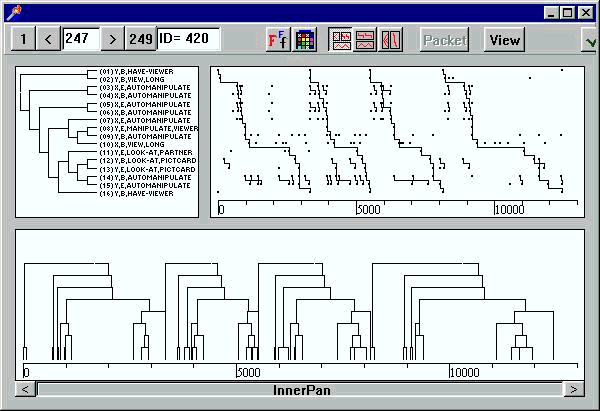Real-time pattern detection versus standard
sequential and time series analysis
M.S. Magnusson
Human Behavior Laboratory, University of Iceland,
Reykjavik, Iceland
A multivariate time pattern type corresponding to a large variety of everyday behavior and social
interaction patterns is proposed. The definition and detection of this type of pattern considers
the order of pattern components, the time intervals between them and the real-time location of each
pattern component within each pattern occurrence. -- The difficulty of seeing (perceiving) many
such patterns directly, even under relatively optimal conditions, is illustrated as well as the
difficulty of detecting such patterns with standard sequential and time series analysis methods.
A computational detection procedure and software (Theme)
has been developed for the detection of
this kind of (hierarchical/syntactical) temporal behavior patterns (T-patterns). This heuristic
search procedure is based directly on elementary probability theory. It searches for a particular
statistical relationship between all pairs of time point series, in a given data set, where each
series represents the occurrence times of a behavioral event type. Based on information obtained
through this search the procedure constructs/detects patterns of increasing complexity. As the
same underlying behavior pattern can thus be detected in many partial and redundant ways, which
can easily lead to combinatorial explosion, the procedure also involves competition and selection
of patterns such that only the most complete or longest patterns survive. The method has now been
tested for robustness through simulation (statistical experiments) and the essential results are
presented.
 |
| Figure 1. This screenshot shows a social interaction pattern detected with
Theme in a dyad between two five-year-old girls (X and Y) playing together with a single picture
VIEWER for 13.5 min. Only one of them could VIEW each PICTURE CARD at the same time. An "event type"
here means some actor's beginning (B) or ending (E) of some behavior. For example, "X,B,LOOK-AT,PARTNER"
(see figure) is an event type meaning: "actor X begins looking at her partner". Nearly 100 different
event types occurred in this dyad. Theme discovered that the 16 event types (leaves) of this pattern
occurred four times in a similar temporal configuration. The top left box shows its (recursive)
hierarchical structure as a pattern of event types or of other patterns of the same kind and
reflects Theme's bottom-up gradual detection method. The top right box (1/15 s time scale) shows the
occurrence time points for each of the 16 event types and the way they get connected. The four
occurrences of the pattern (tree) are shown below with leaves 1 to 16 ordered by their occurrence
times within the pattern, i.e. from left to right. Note that the last pattern occurrence is somewhat
longer (slower) and then the children stopped playing. (LONG means > 3 sec. AUTOMANIPULATE means
"fiddle with something without watching it".). |
Illustrative examples of patterns detected in various kinds of behavior some of which was coded
with The
Observer are presented (see Figure 1 for an example). Applications of this particular
pattern detection approach in the analysis of social and therapeutic interactions in autistic and
handicapped children are cited [1, 2, 3, 5, 6, 7, 8] but application in the analysis of football
and boxing is in progress [4] as well as in combined behavioral and physiological studies of sleep.
References
- Beaudichon, J.; Legros, S.; Magnusson, M.S. (1991). Organisation des régulations inter- et
intrapersonnelles dans la transmission d'informations complexes organisées. Bulletin de Psychologie,
44, no. 399 (édition speciale).
- Blanchet, A.; Magnusson, M.S. (1988). Processes cognitifs et programmation discursive
dans l'entretien de recherche. Psychologie Française, 33 (1/2), 91-98.
- Grammer, K.; Kruck, K.B. ; Magnusson, M.S. (1998). The courtship dance: patterns of
nonverbal synchronization in opposite-sex encounters. Journal of Nonverbal Behavior, 22, 3-29.
- Jonsson, G.K. (1998). Detecting patterns in complex behavioral processes with The Observer
and Theme. This volume.
- Lyon, M.; Lyon, N.; Magnusson, M.S. (1994). The importance of temporal structure in analyzing
schizophrenic behavior: some theoretical and diagnostic implications. Schizophrenia Research, 13, 45-56.
- Magnusson, M.S. (1989). Structures syntaxiques et rythmes comportementaux: sur la détection
de rythmes cachés. Sciences et Techniques de l'Animal du Laboratoire, 14, 143-147.
- Magnusson, M.S. (1996). Hidden real-time patterns in intra- and inter-individual behavior:
description and detection. European Journal of Psychological Assessment, 12, 112-123.
- Montagner, H.; Magnusson, M.S.; Casagrande, C.; Restoin, A.; Bel, J.P.; Nhuyen, M.; Hoang,
P.; Ruiz, V.; Delcourt, S.; Gaufeier, G.; Epoulet, B. (1990). Une nouvelle méthode pour l'étude
des organisateurs de comportement et systèmes d'interaction du jeune enfant. Psychiatrie de
l'Enfant, 33, 391-456.

Paper presented at Measuring Behavior '98,
2nd International Conference on Methods and Techniques in Behavioral Research,
18-21 August 1998, Groningen, The Netherlands
© 1998 Noldus Information Technology b.v.

